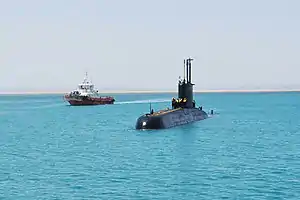Shishumar-class submarine
The Shishumar-class submarines are diesel-electric attack submarines, currently in active service with the Indian Navy. These submarines are an Indian variant[4] of the Type 209 submarines developed by the German yard Howaldtswerke-Deutsche Werft under the internal designation "Type 1500". The first two vessels were built by HDW at Kiel, Germany, while the remainder were built by Mazagon Dock Limited, at Mumbai, India, under a technology transfer agreement.[5] The submarines were commissioned between 1986 and 1994. These submarines have a displacement of 1,660 tons when surfaced, a speed of 22 knots (41 km/h; 25 mph), and a complement of 40 including eight officers.
 INS Shishumar enters Port of Duqm, Oman. | |
| Class overview | |
|---|---|
| Name | Shishumar class |
| Builders | |
| Operators | |
| Preceded by | Vela class |
| Succeeded by | Kalvari class |
| Cost | €300 million each[1] |
| In commission | 1986–present |
| Planned | 6 |
| Completed | 4 |
| Cancelled | 2 |
| Active | 4 |
| General characteristics [2] | |
| Type | Attack submarine |
| Displacement | |
| Length | 64.4 m (211 ft 3 in) |
| Beam | 6.5 m (21 ft 4 in) |
| Draught | 6 m (19 ft 8 in) |
| Propulsion |
|
| Speed |
|
| Range |
|
| Complement | 40 (8 officers) |
| Sensors and processing systems |
|
| Electronic warfare & decoys |
|
| Armament |
|
History
India signed the agreement for these submarines with Howaldtswerke-Deutsche Werft (HDW) on 11 December 1981. The agreement called for building of two submarines in West Germany, the supply of knocked-down kits for assembling two more submarines in Mazagon Dock Limited (MDL), and training for construction and logistics services. An agreement was announced in 1984 for the construction of two additional submarines in MDL, but was subsequently cancelled due to economic crisis in the late 1980s.[2] The four submarines that were finally built form the 10th submarine squadron based at Mumbai.[3]
Mid Life Upgrade
The Indian Navy awarded a $151 million contract for mid-life upgrade and certification of INS Shishumar in 2018. The refit was carried out by MDL at Mumbai with technical cooperation from ThyssenKrupp Marine Systems.[6][7] The refit was planned to be completed by 2021 with a similar upgrade for another vessel of Shishumar-class submarine to follow. [6] The ship was expected to be delivered by 2021 but owing to Covid-19 delays the ship will now be delivered to the Indian Navy in August 2023.[8]
Similarly, a second mid-life upgrade contract was awarded to the Mazagon Dock for refit and life certification of the 2nd submarine Shankush on 30 June 2023. The completion date of mid-life upgrade and certification is 2026. The total estimated cost to be around ₹2,725 crore (US$340 million).[9]
Total 3 ships out of 4 will undergo mid-life refit and certification, this will extend the life of the submarine by 10–15 years.[8]
Ships of the class
| Name | Pennant | Builder | Laid down | Launched | Commissioned | Upgrade | Homeport | Note |
|---|---|---|---|---|---|---|---|---|
| Shishumar | S44 | Howaldtswerke-Deutsche Werft | 1 May 1982 | 13 December 1984 | 22 September 1986 | 2018 — 2023[6][8] | Mumbai | [2] |
| Shankush | S45 | 1 September 1982 | 11 May 1984 | 20 November 1986 | 2023 — 2026[9] | [2] | ||
| Shalki | S46 | Mazagon Dock | 5 June 1984 | 30 September 1989 | 7 February 1992 | — | [2] | |
| Shankul | S47 | 3 September 1989 | 21 March 1992 | 28 May 1994 | — | [2] | ||
Commissions received during the order
In a July 2005 interview with NDTV, V. P. Singh said that in 1987, while he was a minister, he had received a telegram from the Indian ambassador in Germany with the information that Indian agents had received large illegal commissions in the HDW submarine deal.[10] Singh informed the then prime minister Rajiv Gandhi about this and instituted an enquiry. Subsequently, this led to differences and Singh decided to resign from the cabinet.[11]
See also
References
- "The Greek submarine scandal and HDW". www.sites.tufts.edu. World peace foundation. Retrieved 25 October 2018.
- Commodore Stephen Saunders, ed. (2004). "India". Jane's Fighting Ships 2004-2005 (107th ed.). Coulsdon: Jane's Information Group. p. 305. ISBN 978-0710626233.
- Gady, Franz-Stefan (14 July 2016). "Germany to Upgrade Two Indian Attack Submarines". The Diplomat.
- The Indian Strategic Nuclear Submarine Project An Open Literature Analysis
- Nair-Ghaswalla, Amrita (2 December 2015). "ThyssenKrupp bullish on defence sector". The Hindu Business Line.
- "Germany's Thyssenkrupp to refit Indian Navy submarine INS Shishumar". 26 September 2018. Retrieved 27 September 2018.
- "India's Mazagon Dock, Germany's Thyssenkrupp Bag $151M Worth Indian Navy Submarines Refit Contract". DefenseWorld.net. 27 September 2018. Retrieved 6 July 2019.
- Peri, Dinaker (1 July 2023). "Submarine INS Shankush to undergo life extension at MDL under ₹2,725-crore contract". The Hindu.
- "MoD signs a contract of Rs. 2725 Cr with Mazagon Dock Shipbuilders Ltd for Medium Refit with Life Certification of Submarine INS Shankush". PIB (Press release). 30 June 2023.
- Gupta, Shekhar (1 July 2005). "Walk the talk - an interview with V.P.Singh". NDTV. Retrieved 25 October 2018.
- "India charges 6 over submarine kickbacks". New York Times. 7 March 1990. Retrieved 25 October 2018.
External links
